At just 44 hectares, this fortified hilltop on the right bank of the Tiber is the smallest and least populated country in the world.
And yet, as the temporal seat of the pope and the main episcopal see for the Catholic Church, Vatican City holds enormous cultural importance.
That status is underpinned by some of the finest art and architecture conceived by humankind, as well landmarks known to all without a second glance.
The history is almost palpable, in a place shaped over many centuries by men wielding huge power, and enriched with timeless works by Michelangelo, Raphael and Bernini.
Whatever your personal beliefs, Vatican City has enough to keep you rapt for days on end.
1. St Peter’s Basilica
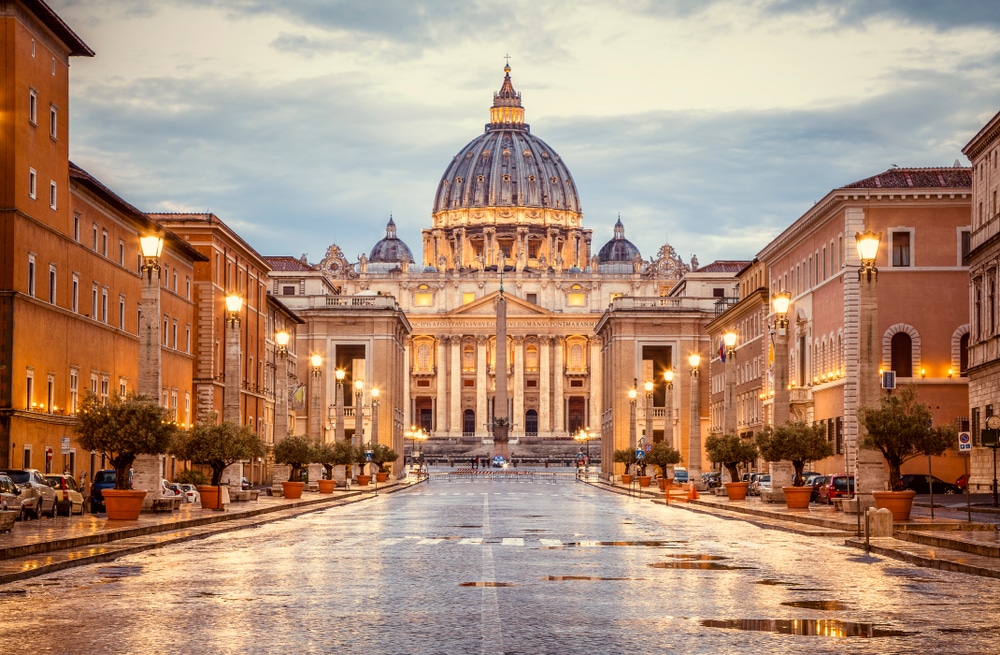 Source: Vladimir Sazonov / Shutterstock
Source: Vladimir Sazonov / ShutterstockOfficially the largest church in the world, St Peter’s Basilica occupies a unique place in Christendom as one of the holiest Catholic pilgrimage sites.
This is thought to be the burial place of Peter the Apostle, and is the scene of numerous liturgies given by the pope throughout the year, both inside and on St Peter’s Square.
The building, begun in 1506 and completed in 1626, is predominantly in a Renaissance style and despite its vast scale never feels overwhelming.
This is down to its masterful sense of proportion, care of the most prestigious lineup of architects ever recruited, including Michelangelo, Bramante and Bernini.
The latter took charge of much of the decoration, including the immense baldachin over the High Altar, along with the marvellous Chair of St Peter.
There’s a long list of things you have to see and do at St Peter’s, and we’ll talk about many later in this list.
The dome, initiated by Michelangelo, is of course integral, reaching a record-breaking height of 136.57 metres. You can battle to the top via 323 steps or catch an elevator to behold a view for the ages.
2. Vatican Museums
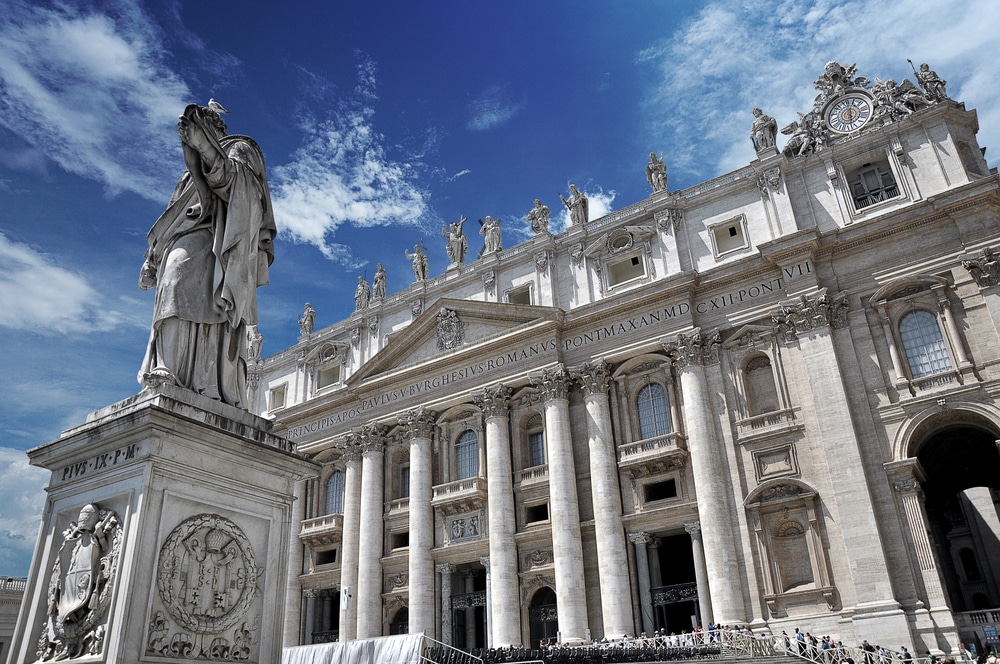 Source: Firat Cetin / Shutterstock
Source: Firat Cetin / ShutterstockOccupying large portions of the historic and sprawling Apostolic Palace is one of the largest museums anywhere, with a dumbfounding wealth of art.
The Vatican Museums abound with world-renowned masterpieces, some of which are in situ, like the Raphael Rooms for Pope Julius II or Michelangelo’s Sistine Chapel frescoes.
We have separate entries for these, as well as the amazing painting and contemporary art collections and the astounding Gallery of Maps.
That still leaves room for a lot more, especially in the museums around the long Belvedere Courtyard.
These are littered with Egyptian, Greek, Etruscan, but mostly Roman statues, sarcophagi, friezes, busts, tablets, inscriptions and much more.
Among the world-famous standouts are the Augustus of Prima Porta, Statue of the Nile and the Doryphoros at the Chiaramonti Museum.
The Pio-Clementino Museum meanwhile is famed for the famous Bramante Staircase, with a shallow ramp on a beautiful double-helix.
Dating to 1932, this was designed by Giuseppe Momo and based on the surviving original from 1505, which allowed allowing Pope Julius II to enter his private apartment without leaving his carriage.
3. Sistine Chapel
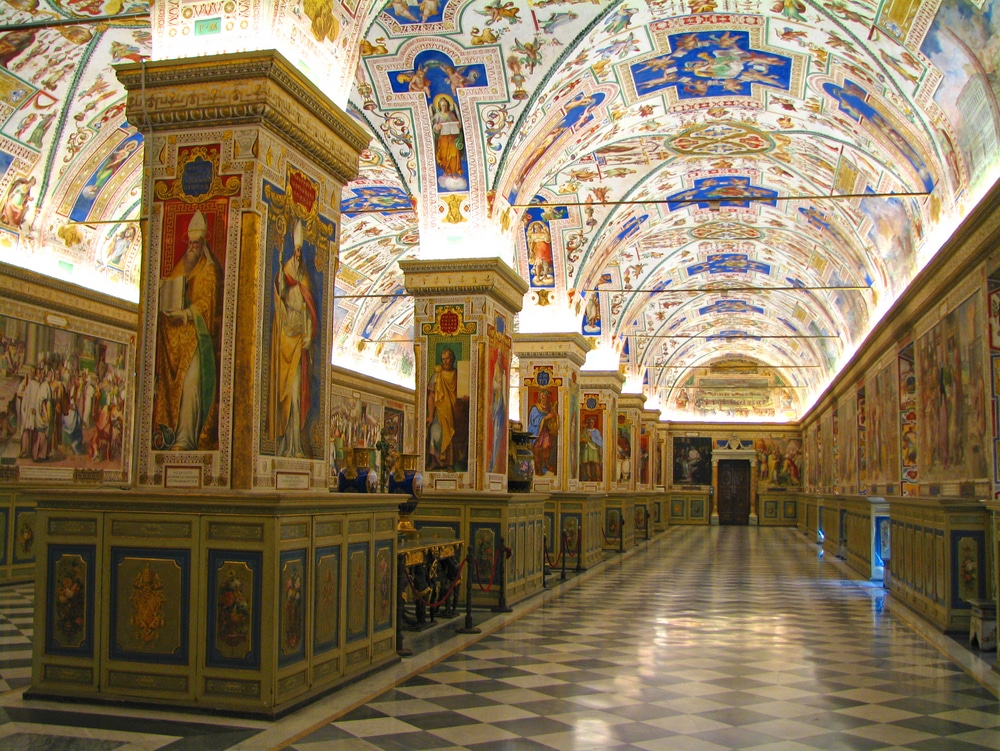 Source: Checco2 / Shutterstock
Source: Checco2 / ShutterstockThe importance of this world-renowned chapel in the Apostolic Palace is multifaceted.
First, in a purely utilitarian sense it’s the setting for the papal conclave to select the next pope, with the chimney emitting black smoke if no pope has yet been chosen and white if a new pope has been elected.
Then of course there’s the art inside, and the Sistine Chapel is a byword for a crowning achievement in an artist’s career.
The building is named for Pope Sixtus IV, who oversaw its restoration from 1473 to 1481.
In the early-1580s a dream team of Early Renaissance painters was recruited to paint the frescoes on the Northern (Stories of Moses) and Southern Walls (Stories of Jesus). This included Botticelli, Perugino, Signorelli and their workshops.
Then, from 1508, Michelangelo painted the enormous ceiling, anchored by nine scenes from the Book of Genesis.
These are accompanied by depictions of Prophets and Sibyls, the ancestors of Jesus and many more images around the edges, spandrels, window arches and pendentives.
The Sistine Chapel ceiling is of course one of the most influential and treasured works in the history of art and instantly recognised by one of the central panels showing God creating Adam.
Michelangelo returned to the chapel some 20 years later, to paint the Last Judgment, which we’ll talk about later.
4. St Peter’s Square
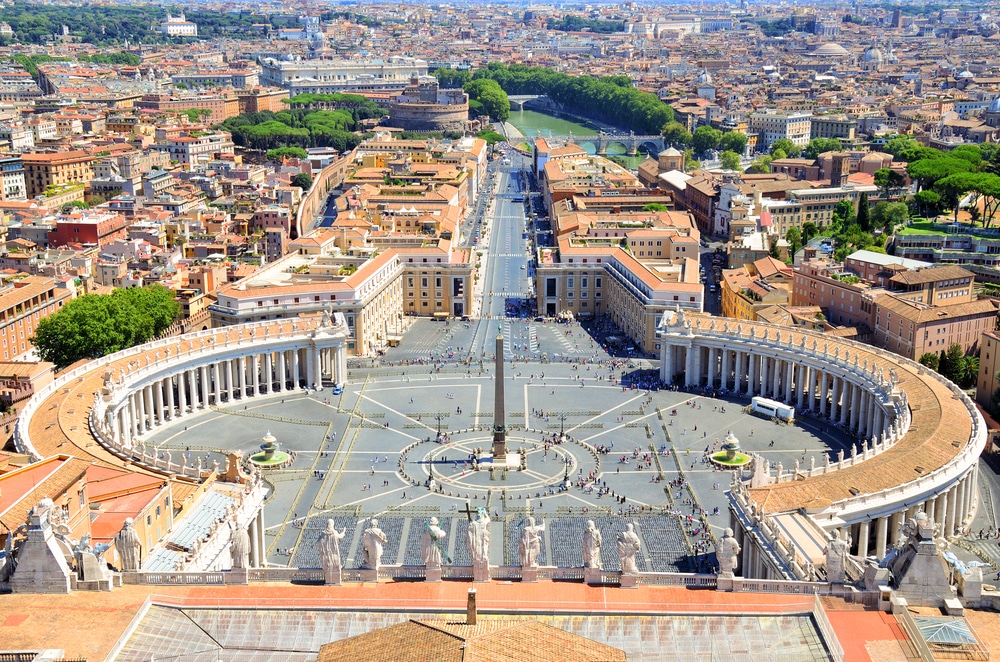 Source: dezign80 / Shutterstock
Source: dezign80 / ShutterstockNobody would complain if you called the epic plaza in front of St Peter’s Basilica the most beautiful square ever created.
For this we have Bernini to thank. From 1656 to 1667 he set about remodelling this space as an appropriately grand venue for Pope Alexander VII’s blessings, either from the facade of the basilica or the papal apartments to the north-west.
Bernini’s answer to this geometrical challenge was to create an elliptical plan, centred on the Ancient Egyptian obelisk, which we’ll cover in more detail below.
The plaza’s shape is defined by a pair of marvellous, curving colonnades in the Doric order and four rows deep.
St Peter’s Square is bordered by 284 columns and 88 pilasters in all, and cresting the balustrade at the top are 140 statues of saints, carved by Bernini’s workshop.
The radiating travertine lines embedded in the paving date to 1817 and serve as a sundial, turning that obelisk into a massive gnomon.
5. Michelangelo’s Pietà
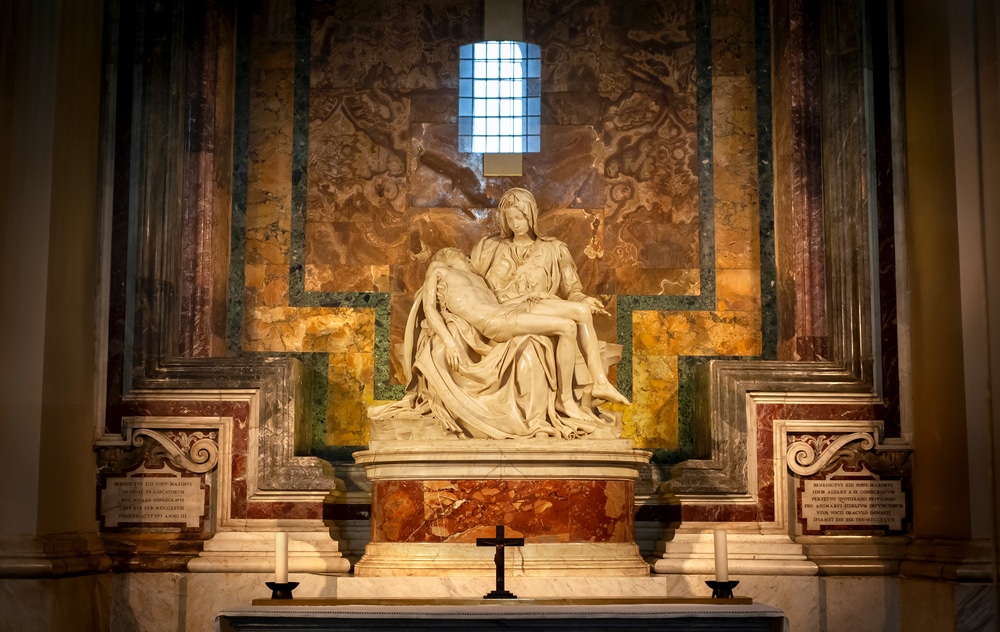 Source: StrippedPixel.com / Shutterstock
Source: StrippedPixel.com / ShutterstockThe first chapel on the north aisle of St Peter’s Basilica houses one of humanity’s most famous and most celebrated works of art.
As is often repeated, Michelangelo was only 24 years old when he completed this piece, carved from a single block of Carrara marble.
Depicting the traditional Pietà scene of Mary cradling the body of Jesus, this sculpture was commissioned in 1498 by the Cardinal Jean Bilhères de Lagraulas for his grave monument, but was relocated to its current position by the Holy Door in the 18th century.
The Pietà is the only work that Michelangelo ever signed, to avoid a competitor taking credit for it, and among its many sublime details are the complex and masterfully rendered folds of Mary’s cloak.
There are several explanations for Mary’s noticeably youthful depiction, and one might come from Dante’s Divine Comedy, with which Michelangelo was besotted.
To Dante, as Jesus was a member of the Holy Trinity, Mary would also be his daughter as well as the woman who bore him.
6. The Last Judgment
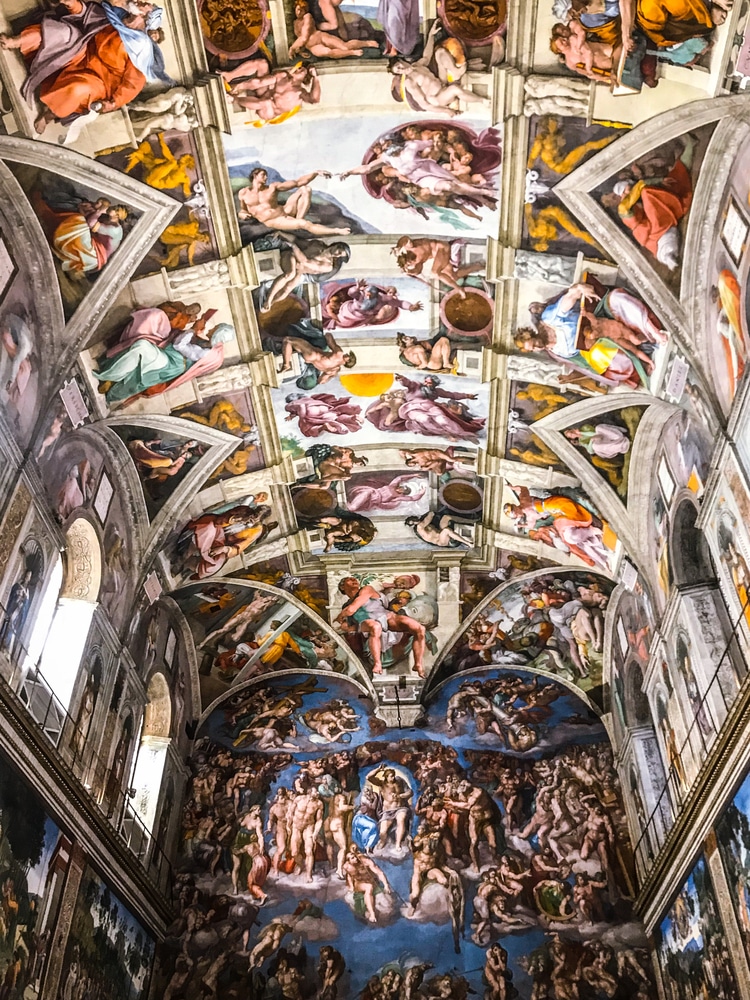 Source: Eric Isselee / Shutterstock
Source: Eric Isselee / ShutterstockTwenty-five years after he finished the Sistine Chapel ceiling, Michelangelo went to work on the wall behind the altar.
This extraordinary fresco took more than four years to paint, between 1536 and 1541, and depicts the Second Coming of Christ and the last judgment of God of all humanity.
There’s some interesting context to this brooding work, as the Sack of Rome by the mutinous troops of Holy Roman Emperor, Charles V had taken place in 1527, and the city was in a slow recovery.
Right above the altar is the mouth of hell, and, as ever, the damned descend to hell on God’s left side and the saved ascend on his right.
There are more than 300 figures in the painting, and countless absorbing details to take in. At the feet of Jesus is St Bartholomew, who according to popular hagiography was flayed alive.
The skin that he’s holding in Michelangelo’s fresco is believed to be a self-portrait by the artist. The Last Judgment caused a scandal when it was completed, and its strongest critic was the future Pope Paul IV (1476-1559).
Among the first acts of his pontificate were to cut off Michelangelo’s pension and commission fig-leaves and drapery for many of the Last Judgment’s nudes.
Those original alterations are still in place, while the changes made for the sake of modesty in the 17th century have been removed.
7. Raphael Rooms
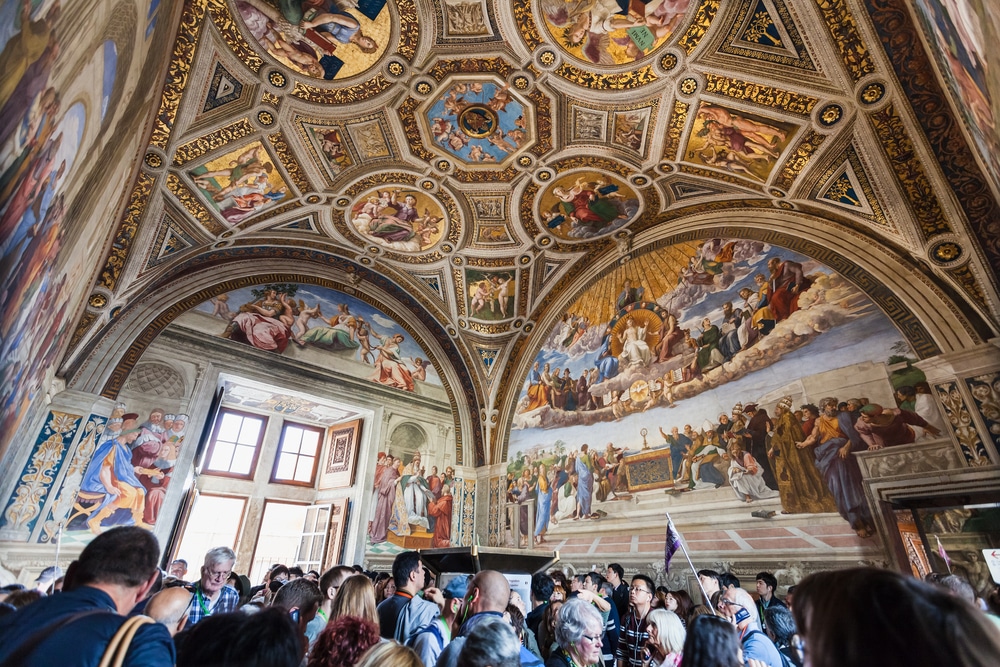 Source: vvoe / Shutterstock
Source: vvoe / ShutterstockIn 1508 Pope Julius II commissioned a young Raphael, who had only just arrived in Rome, to adorn his suite apartments with frescoes.
Along with Michelangelo’s Sistine Chapel Ceiling, this sequence of frescoes marks the High Renaissance in Rome and is now part of the Vatican Museums.
The first of these rooms to be painted was the Stanza della Segnatura, the study containing Julius II’s library.
Comprising the School of Athens, The Parnassus and The Disputa, this caused a sensation in Roman art and is remembered as the outstanding masterpiece of Raphael’s career.
Initially the rooms were to be painted by a team of artists, but Raphael’s work was such a success that he was given the rest to paint.
As it went on, Raphael provided the drawings and the frescoes were completed by the large and skilled workshop he had built up, even after his death in 1520.
8. Castel Sant’Angelo
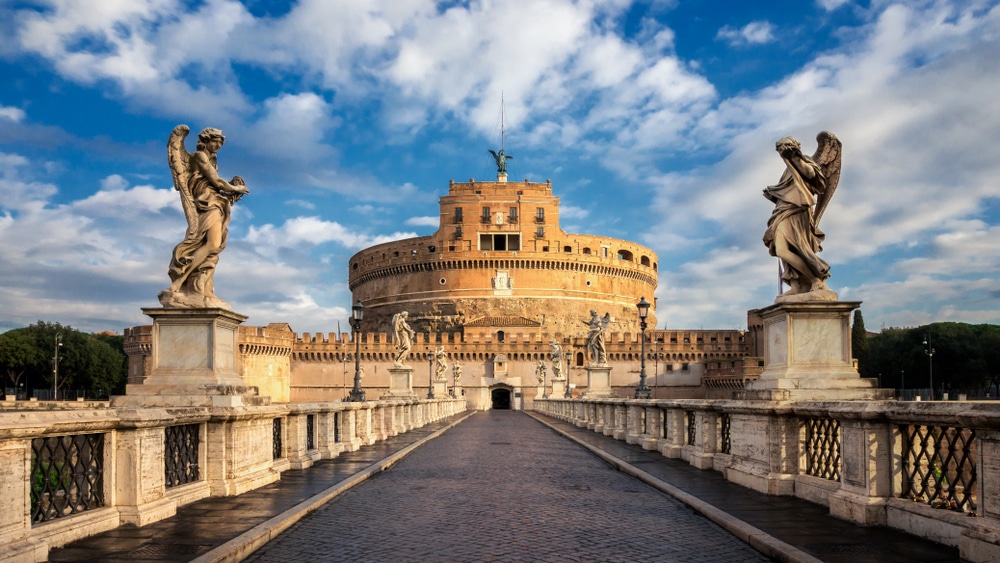 Source: Blue Planet Studio / Shutterstock
Source: Blue Planet Studio / ShutterstockRight next door to Vatican City on the right bank of the Tiber, this bold, cylindrical monument has a history inextricably linked with the papacy.
Once the tallest building in Rome, the Castel Sant’Angelo dates all the way back to the 130s and was commissioned by Emperor Hadrian as his mausoleum.
The tombs of several other emperors were also erected here, but were later scattered during Alaric’s sacking of Rome in the 5th century.
In the Middle Ages this formidable building became a stronghold for popes in times of crisis. Popes in peril would be spirited here via the Passetto di Borgo, the 13th-century, 800-metre fortified corridor connecting the castle to the Vatican City.
The most dramatic way to approach the Castel Sant’Angelo is on the namesake bridge, also ordered by Hadrian and flanked by ten Baroque angels from the 17th century.
Looking up to the roof of the castle, your eye will be drawn to a statue of the Archangel Michael, sheathing his sword.
This refers to a legend in which the Archangel appeared here in 590 to signal the end of an outbreak of plague. Inside you can view the chambers that served as a papal residence, and a spiral ramp lifts you up five storeys for one of the great views of the Eternal City.
9. Gardens of Vatican City
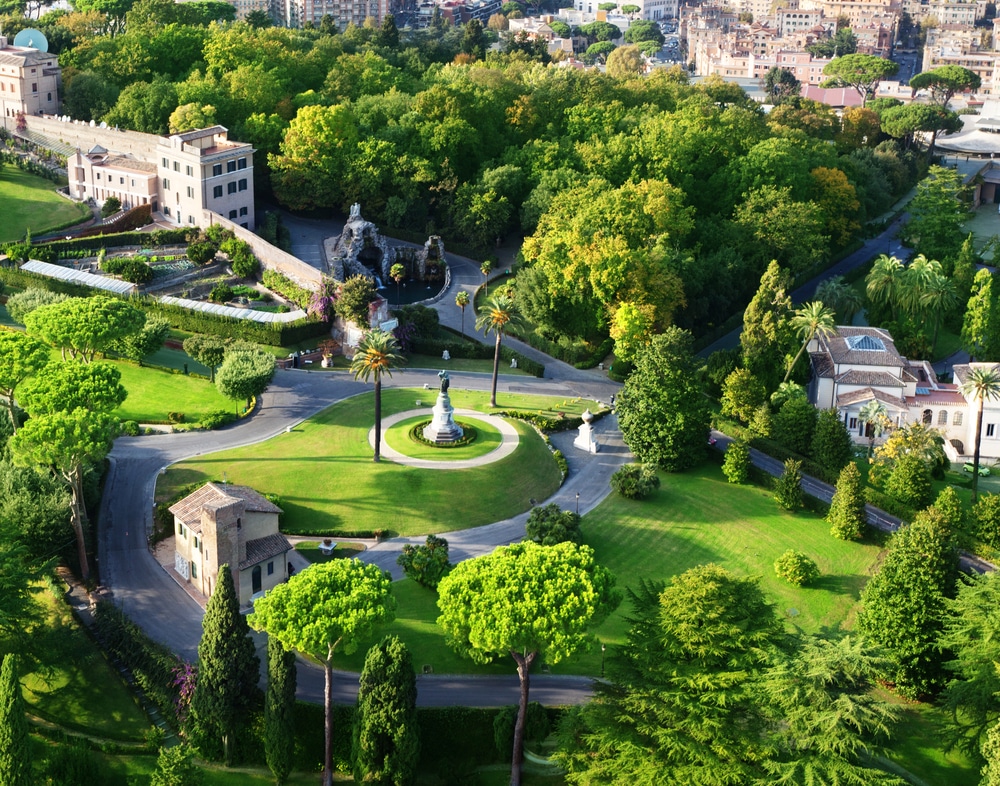 Source: Iakov Kalinin / Shutterstock
Source: Iakov Kalinin / ShutterstockClosed to the public until as recently as 2014, the Pope’s private gardens take up more than half of the country, at 32 hectares.
The gardens encompass much of the central and western portions of Vatican City and have Medieval origins as orchards and vineyards for the Apostolic Palace, as well as an early medicinal garden for the 13th-century Pope Nicholas III.
These were remodelled at the start of the 16th century in the Italian Renaissance style, and there are now formal French and rambling English gardens, the latter complete with a pagoda.
The only way to see the gardens is on a tour, and it’s an experience not to be missed. As well as savouring this little oasis in a chaotic city, you’ll see lots of memorable curiosities.
Just to sum up there’s the Medieval defensive walls, the Vatican’s helicopter pad, a fragment of the Berlin Wall, specimen plants and trees from around the world, a 16th-century labyrinth, topiaries, fountains and a replica of Lourdes Grotto at the gardens’ highest point.
10. Vatican Necropolis
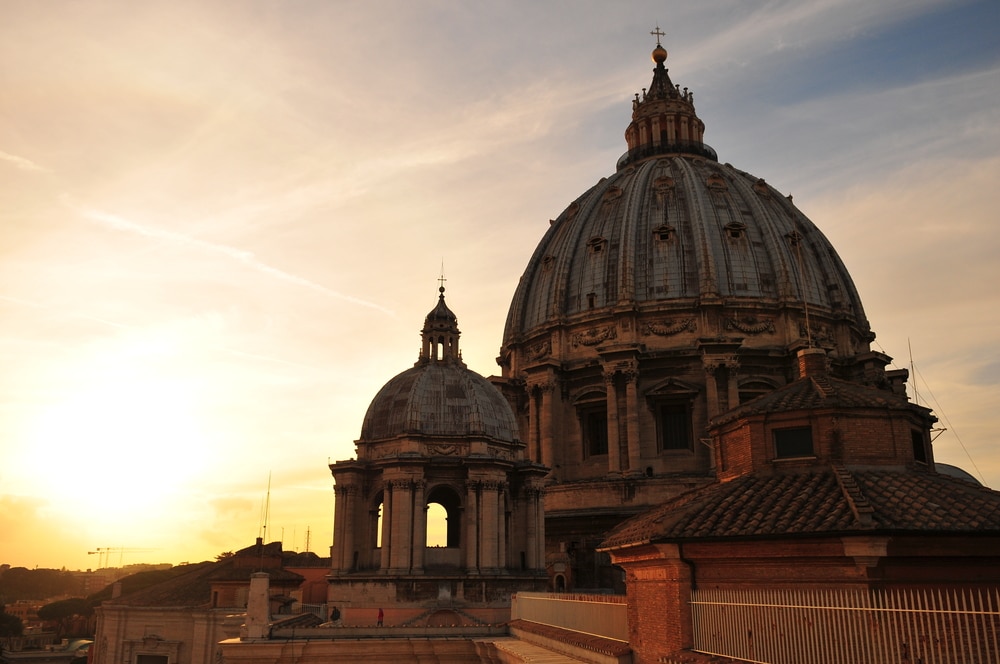 Source: wojtaro76 / Shutterstock
Source: wojtaro76 / ShutterstockBetween 1940 and 1949 Pope Pius XI gave the green light to excavations under St Peter’s Basilica. His aim was to find the burial place of St Peter (c. 67), as he wanted to be buried as closely as possible to the Apostle.
To do this he excavated a complex of mausoleums, dating to between 130 and 300 CE and found at a depth of between five and 12 metres beneath the floor of Renaissance basilica.
St Peter is thought to have been martyred by being crucified upside down and then buried outside of the walls of Ancient Rome on the southern slope of the Vatican Hill.
Later digs unearthed the remainder of the Necropolis and, as the supposed resting place of St Peter, it’s one of the holiest places in Vatican City as well as an exciting journey into the fabric of Ancient Rome.
Tours take just over an hour, and you’ll see some ancient monuments, sculpture and inscriptions, and an early Christian funerary mosaic dating to before the 4th century CE.
11. Vatican Grottoes
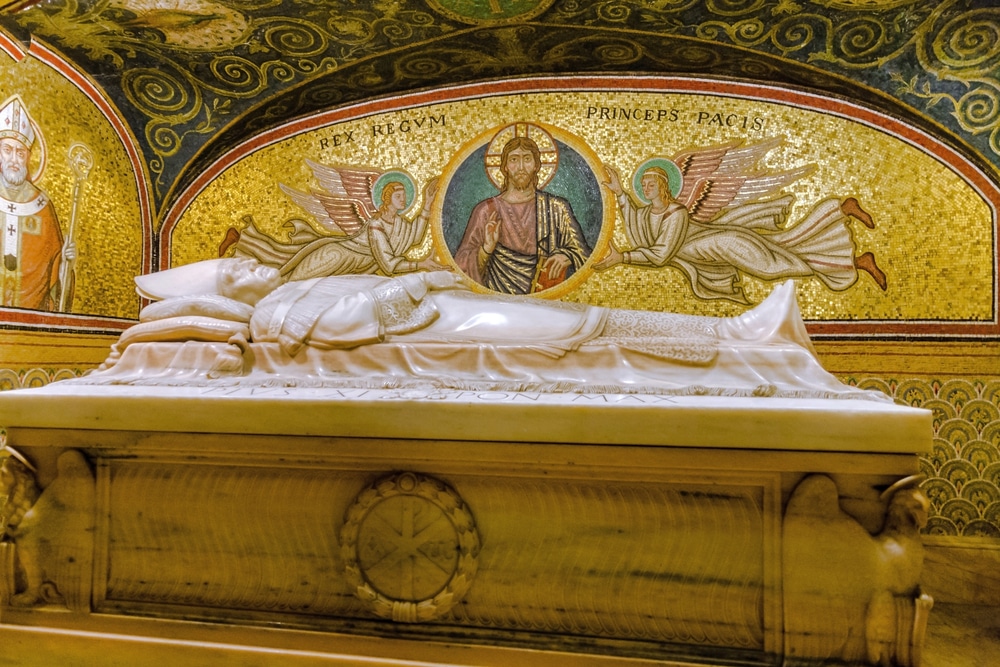 Source: Volodymyr Dvornyk / Shutterstock
Source: Volodymyr Dvornyk / ShutterstockOne level above the Necropolis and the Constantinian Basilica is an immense underground graveyard.
The entrance to the Vatican Grottoes is right by the elevator kiosks to the dome. Found along this network of three-metre-high corridors are the tombs of 91 popes, as well as other prominent figures in the history of Western Christianity and Catholicism.
These include cardinals but also figures like Otto II, Holy Roman Emperor (955-983), Queen Charlotte of Cyprus (1444-1487), members of the Royal House of Stuart and the famous Catholic convert, Christina, Queen of Sweden (1626-1689).
It’s a good idea to tour the Vatican Grottoes with someone who knows Latin to help you interpret the inscriptions on the tombs.
It can take hours to see all the sarcophagi, effigies and decoration, each tomb telling you something about the person within and how his contemporaries chose to remember them.
12. Pinacoteca Vaticana
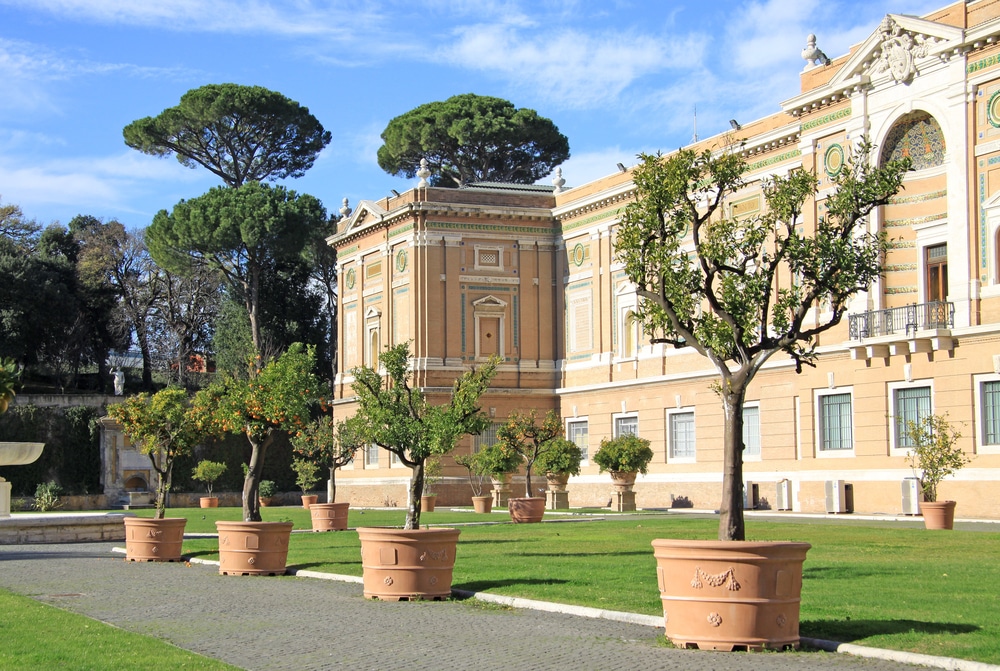 Source: Shiler / shutterstock
Source: Shiler / shutterstockJust how to display the Apostolic Palace’s invaluable fine art collection had been a long-term conundrum until this new gallery building was completed in 1932 under Pope Pius XI.
Apart from during Napoleon’s time when many of these works were transferred to Paris, the Vatican’s collection was built up steadily from the 1790s, and now comprises more than 450 works.
These are on show in 18 rooms in order of chronology and school, from Medieval Primitives up to the 19th century.
In this feast of art there are pieces by Giotto, Fra Angelico, Raphael, Leonardo da Vinci, Perugino, Titian and Caravaggio.
13. Collection of Contemporary Art
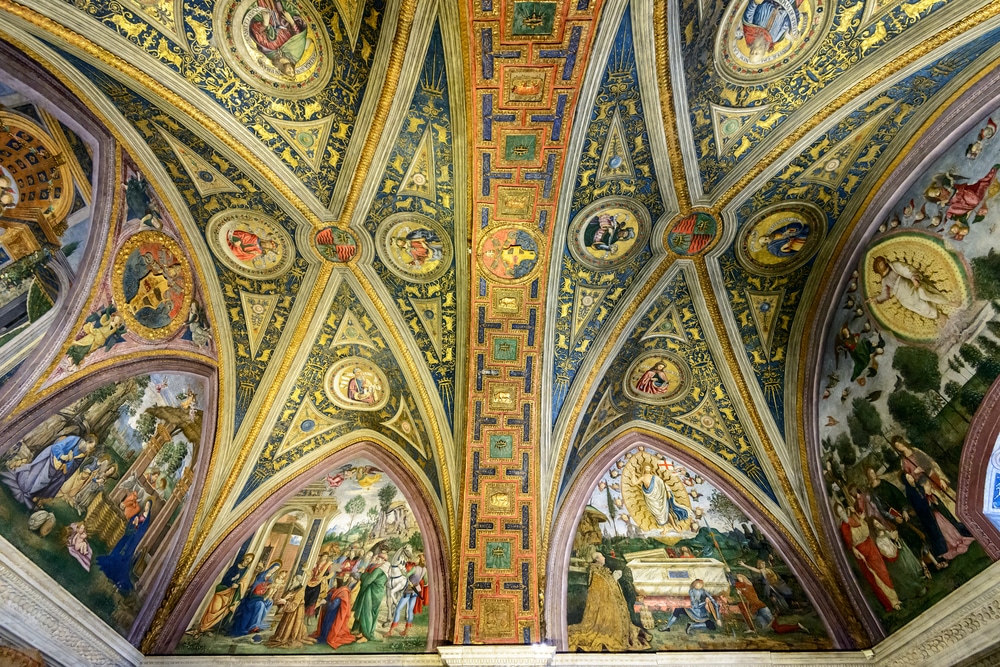 Source: Viacheslav Lopatin / Shutterstock
Source: Viacheslav Lopatin / ShutterstockIn the 1960s, Pope Paul VI (1897-1978) wanted to reestablish the church’s dialogue with contemporary culture and, following a landmark address in 1964, established a ten-year program that assembled an astounding collection of modern religious art.
Comprising some 8,000 pieces of painting, sculpture and graphic art, this collection was mostly donated, and was inaugurated by Paul VI in 1973.
The array of artists represented in the Collection of Contemporary Art rivals any museum in the world, and includes Matisse, Picasso, Francis Bacon, Rodin, van Gogh, Gauguin, Kandinsky, Chagall, Otto Dix and Dalí.
This work is displayed in 55 rooms at the Vatican Museums, among them the Borgia Apartment at the Apostolic Palace and the rooms below the Sistine Chapel.
14. The Angelus
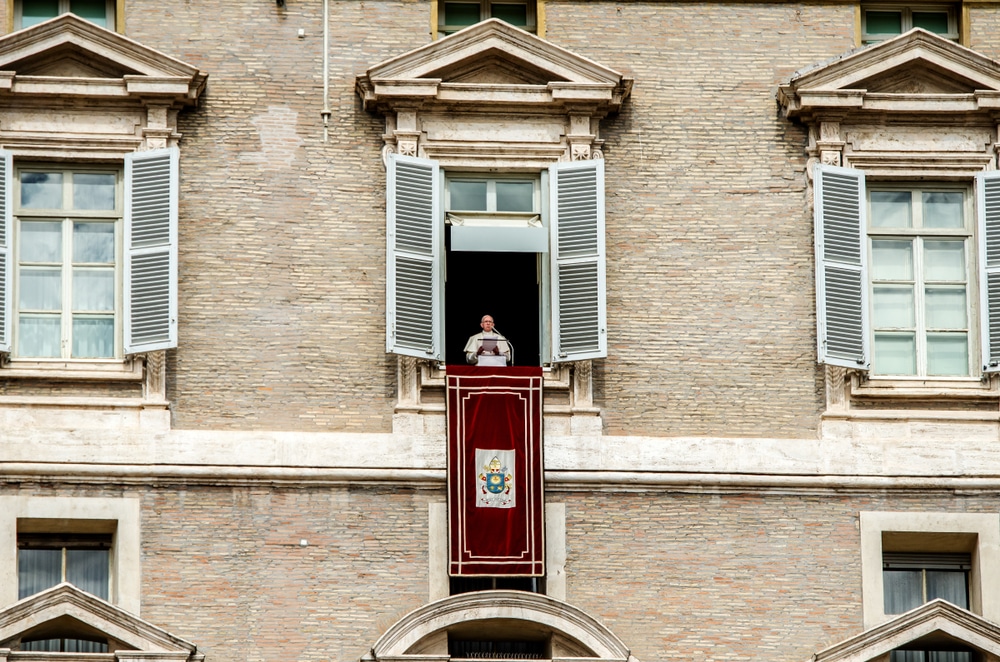 Source: Daria Serdtseva / Shutterstock
Source: Daria Serdtseva / ShutterstockWhatever your religious persuasion, the opportunity to see one of the world’s spiritual leaders in person is not to be passed up.
You can do this when the Pope is in Rome, by heading to St Peter’s Square on Sunday for his Angelus Address, which is given at noon from his window in the papal apartments at the Apostolic Palace.
This ritual has been carried out since the papacy of John XXIII, between 1958 and 1963. The more formal papal audience, taking place at St Peter’s Square or the Aula Paolo VI auditorium every Wednesday at 10:30 is trickier to attend.
For this you can book a place by phone, queue up for a free ticket handed out by the Swiss Guard after noon on Tuesdays.
15. St Peter’s Square Obelisk
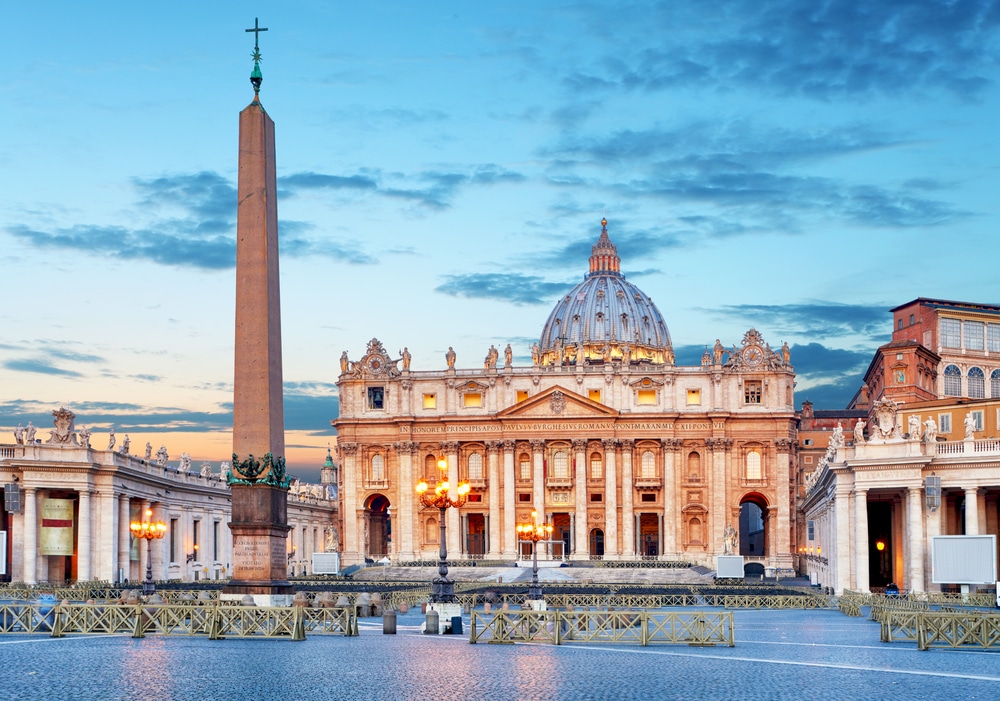 Source: TTstudio / Shutterstock
Source: TTstudio / ShutterstockAt the very centre of St Peter’s Square’s oval is this 25.5-metre Egyptian obelisk, crowned with a cross and adding up to more than 40 metres if you include its base.
It’s amazing to think that this monument, hewn from red granite, is more than 4,000 years old, and was originally erected in the city of Heliopolis, now a suburb of Cairo.
Emperor Augustus moved the obelisk to Alexandria’s Julian Forum, and in 37 CE Caligula had it brought to Rome where it stood along the spina in the middle of the Circus of Nero, located mostly in the present-day Vatican.
Finally, the obelisk was shifted to its current location in 1586 on the orders of Sixtus V, in an effort that took one year and required 900 men and 100 horses.
16. Niccoline Chapel
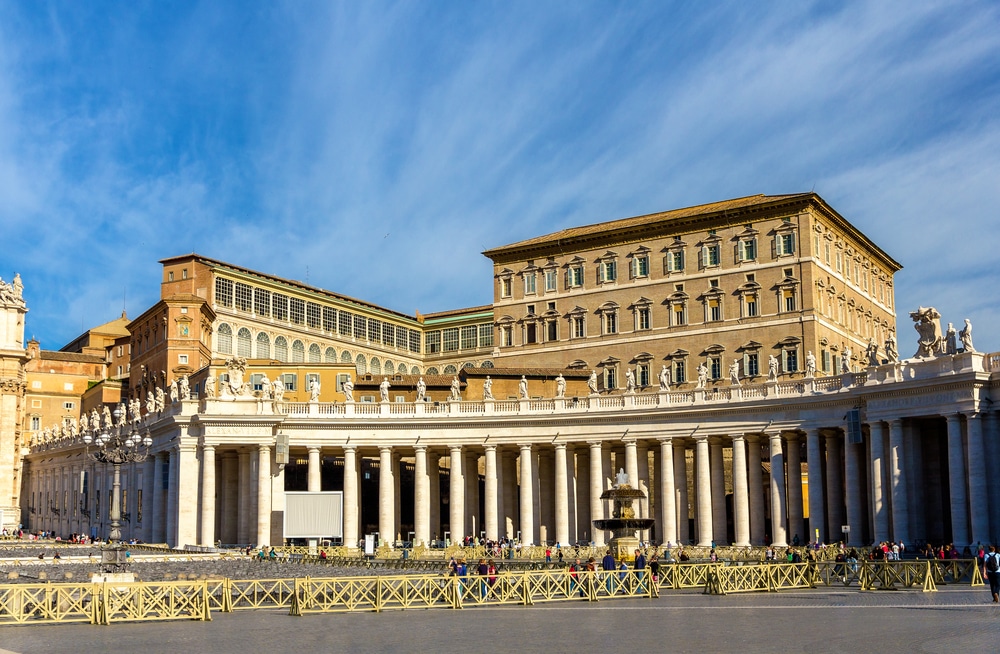 Source: Leonid Andronov / Shutterstock
Source: Leonid Andronov / ShutterstockThe Tower of Innocent III, in the oldest portion of the Apostolic Palace, contains the Niccoline Chapel, commissioned in the 1440s as the private place of worship of Nicholas V (1397-1455).
This space is not normally on the main circuit at the Vatican Museums, but can be seen on a pre-booked tour.
What should push it up your list is its frescoes by Early Renaissance painter Fra Angelico (1395-1455).
These adorn the entire wall and ceiling, rich with gold leaf on their borders and decoration and treasured especially for their mesmerising blues made from lapis lazuli.
In these sequences are The Life of St Stephen (upper level), The Life of St Lawrence (lower level), the Four Evangelists in the corners of the vault and the eight Doctors of the Church on the pilasters.
The paintings are full of wonderful architectural details, alluding to Nicholas V’s wish to restore Rome as the capital of Christianity.
17. Monument to Alexander VII
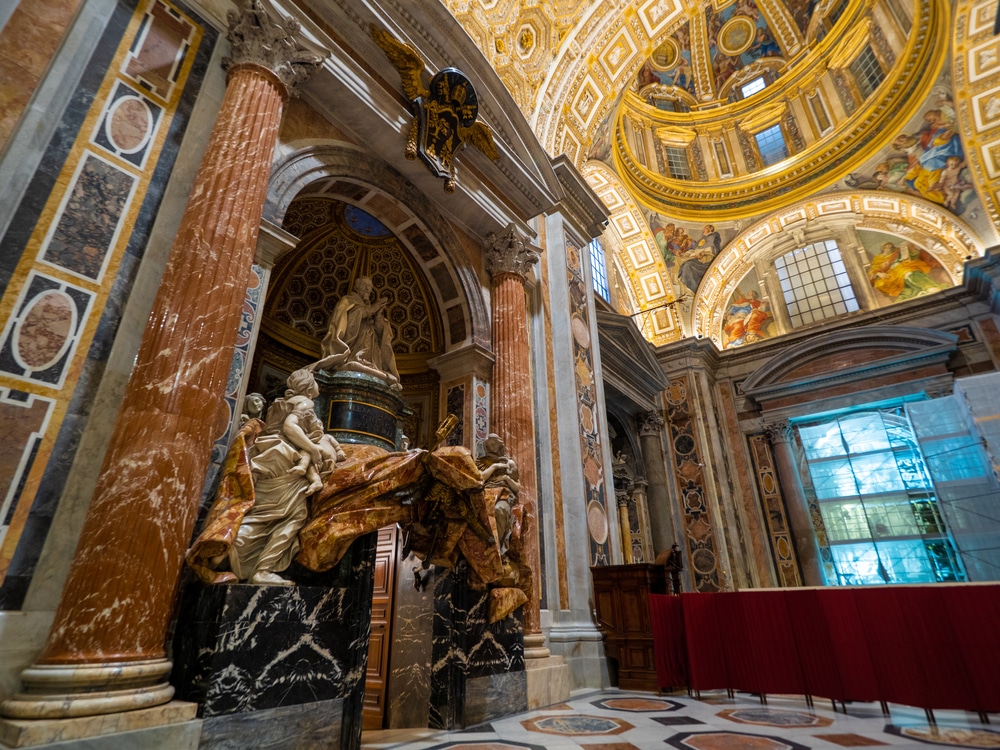 Source: silverfox999 / Shutterstock
Source: silverfox999 / ShutterstockTowards the end of the basilica’s south aisle is Bernini’s staggering tomb for Pope Alexander VII (1599-1667), carved from precious marble in many colours.
The sculptor was 80 years old and at the end of his own life when he carved this masterpiece in 1678.
The tomb has been described as the “pinnacle of European funerary art” and “one of the greatest tombs of the Baroque age”, and is astonishing for the way it made use of an awkward, irregular space at the doorway to a vestry.
That doorway takes on a symbolic meaning, as it is crowned in intimidating style by the gilded statue of a skeleton holding an hourglass.
Dominating the ensemble, Alexander VII is depicted in prayer, to emphasise his spiritual power, and on either side are representations of Charity and Truth.
Take a close look at Truth on the right, and you’ll see her left foot resting on the globe, with her big toe pierced by a thorn emanating from Protestant England.
18. Court of the Pigna
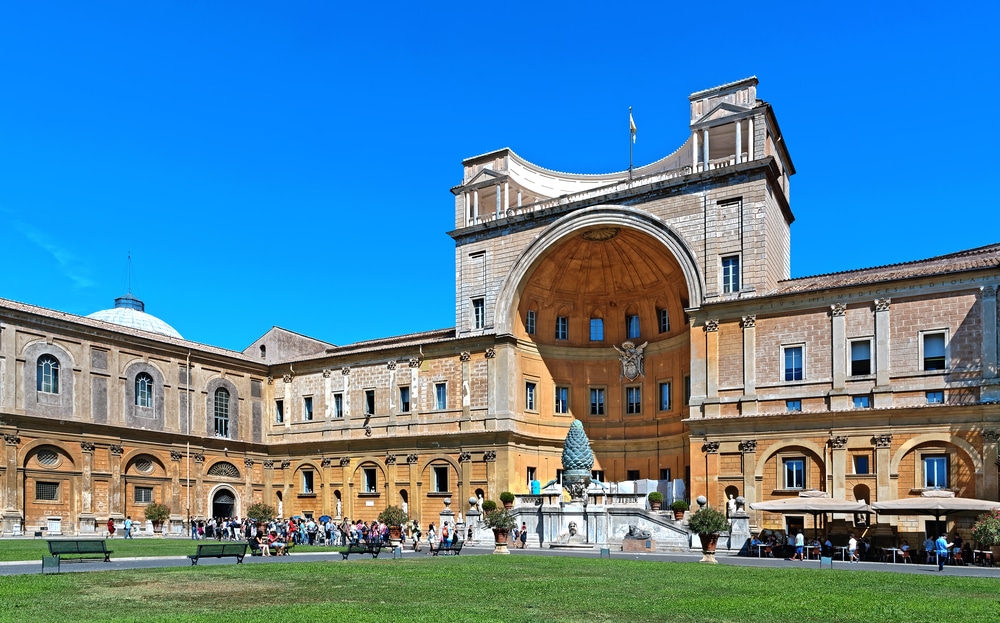 Source: Zoran Karapancev / Shutterstock
Source: Zoran Karapancev / ShutterstockFrom the Sala della Biga at the Vatican Museums you’ll step out onto this courtyard, walled to the north by a massive niche, dating to the 16th century.
At the time this was the largest niche since antiquity and was at the head of the glorious Renaissance Belvedere Courtyard that extended from the Papal Palaces all the way down to the 15th-century Pope Innocent VII’s “palazzetto”, just north of the Sistine Chapel.
That long courtyard was segmented by later constructions, like Sixtus V’s new Library building at the end of the 16th century.
With pride of place in the northernmost Court of the Pigna is the sculpture of a pinecone that gives the space its name.
Cast in bronze and almost four metres tall, this spectacular piece dates to the 2nd Century CE and was originally part of a fountain that most likely decorated the Temple of Isis and Serapis at Campus Martius.
19. Gallery of Maps
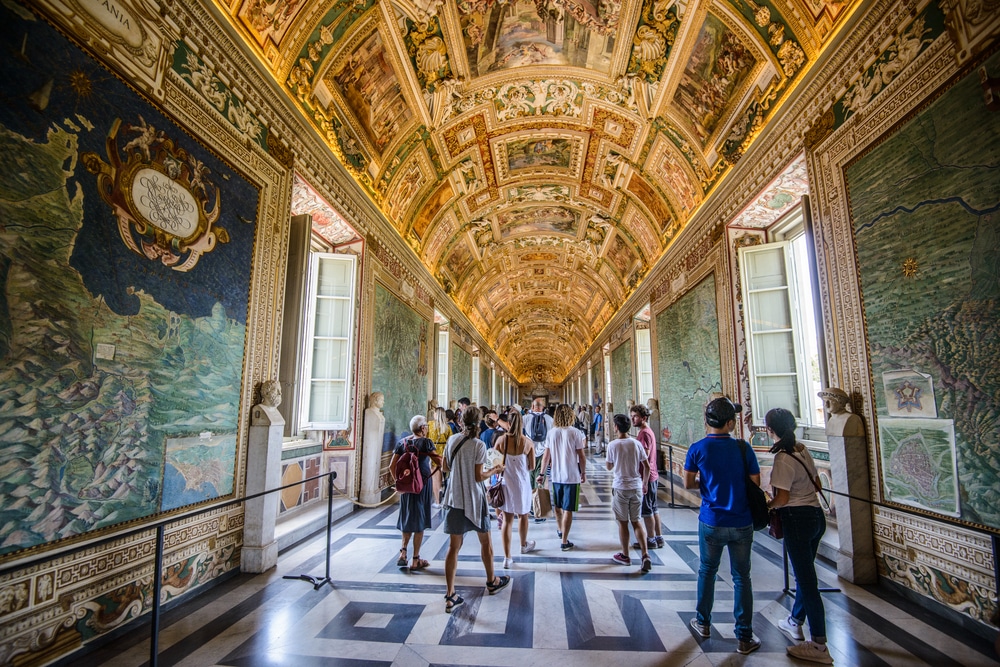 Source: red-feniks / Shutterstock
Source: red-feniks / ShutterstockRunning down the west side of the Belvedere Courtyard is a sensational gallery 120 metres long and decorated in 1580-83 by friar and cartographer Ignazio Danti at the behest of Pope Gregory VIII.
The Gallery of Maps sports a series of topographical maps of Italy in 40 panels. These frescoes have a startling level of accuracy when you consider that they were composed some 440 years ago.
As well as being beautiful to behold, the images are also a riveting historical document, capturing the entirety of the Italian Peninsula, with the Adriatic coast on one side and the Ligurian and Tyrrhenian Seas on the other.
At each end are depictions of the four key Italian ports, Ancona, Civitavecchia, Genoa and Venice, while the barrel vault is embellished with sublime Mannerist art by the likes of Girolamo Muziano and Cesare Nebbia.
20. The Holy Door (Porta Santa)
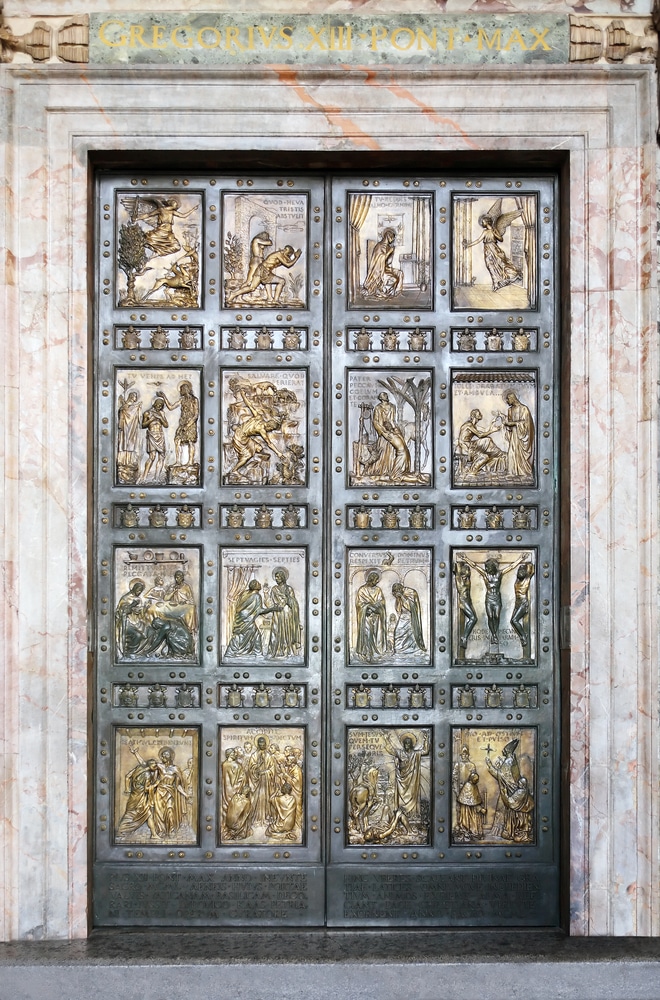 Source: cosma / Shutterstock
Source: cosma / ShutterstockThe last door to the right in the atrium of St Peter’s Basilica is the Holy Door, also known as the Door of the Great Pardon.
This is bricked up from the inside and adorned with a large gold cross, unless you happen to be here during a Jubilee year.
These fall every 25 years, and the next will be in 2025, in a tradition founded by Boniface VIII in 1300.
Catholics make a pilgrimage to Rome, and passing through the Holy Door’s threshold symbolises entering the presence of God. In this act Pilgrims are granted an indulgence, or remission of the temporal punishment of their sins.
In a ceremony on the first day of a Holy Year that wall is knocked down by the pope with a silver hammer.
That ceremony was first mentioned in 1500 under the papacy of Alexander VI. You’ll need to queue up to see the front of the door, which was cast in bronze by Vico Consorti for the 1950 Jubilee.
The 16 panels depict man’s sin and redemption, and are accompanied by coats of arms of the 36 popes to have celebrated Holy Years.
21. Maderno Fountain
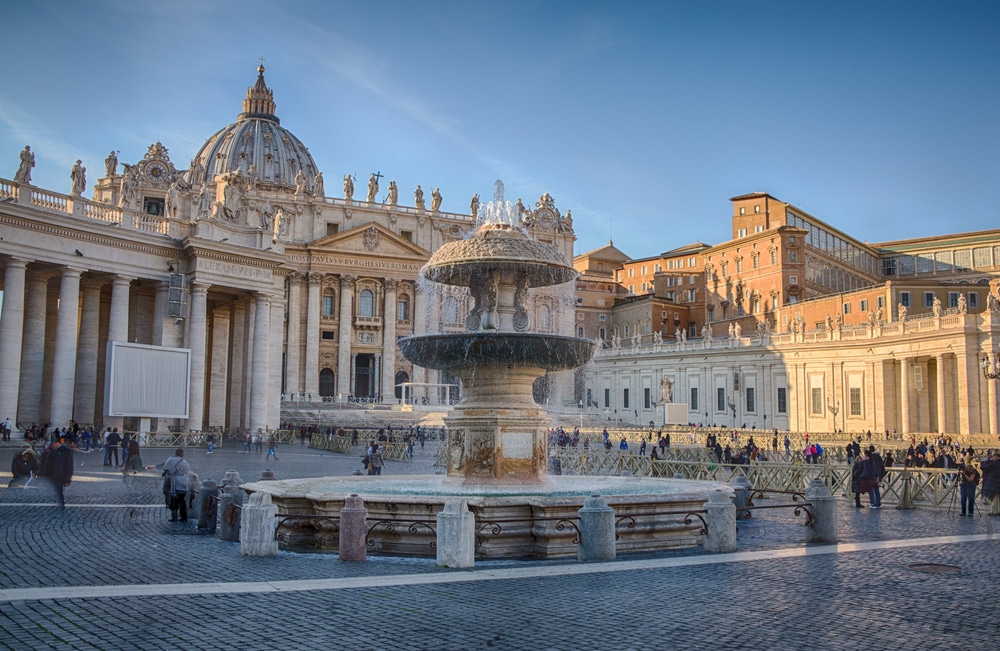 Source: Chedko / Shutterstock
Source: Chedko / ShutterstockYet another of the monuments on St Peter’s Square to be etched into the world’s consciousness is this magnificent Baroque fountain created by Carlo Maderno in 1612-14.
You’ll notice that there are two near-identical fountains framed by the colonnades on the square’s north and south sides.
The one to the north is the original, Maderno fountain, while the fountain to the south was carved by Bernini between 1667 and 1677 and to mimic the Maderno design.
The Maderno Fountain incorporates an important element, the large lower vasque, from a fabled earlier fountain erected here in 1490.
He placed the vasque on an irregular basin and topped it with a smaller, inverted vasque, which has the look of a mushroom cap.
This upper vasque is carved with little stone scales, and when the water flows down from the top it creates a gossamer veil of water.
22. Tomb of Urban VIII
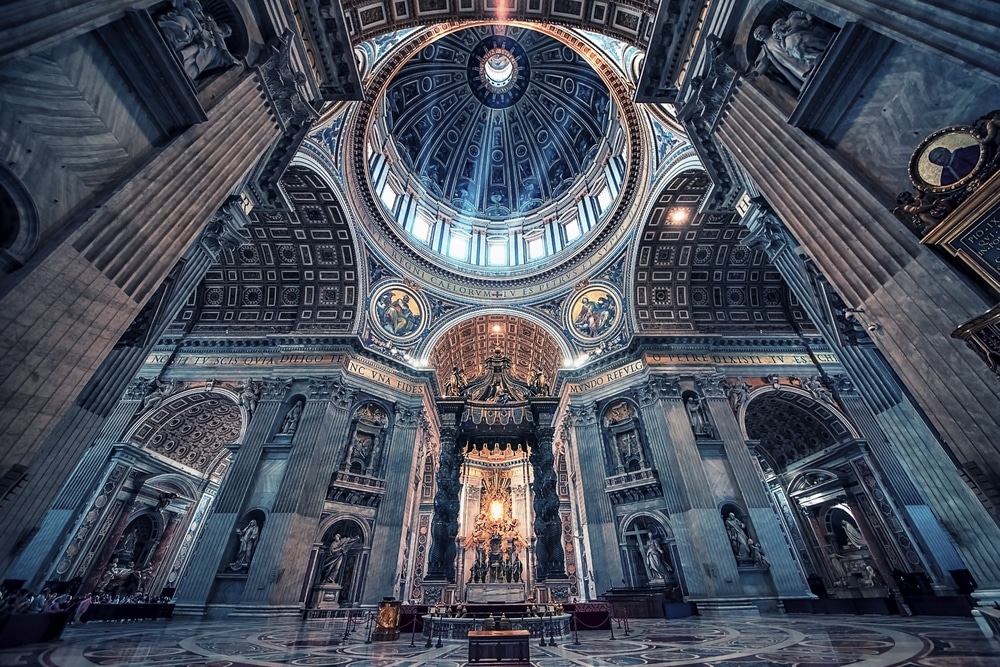 Source: manjik / Shutterstock
Source: manjik / ShutterstockPope Urban VIII was the man who gave licence to Bernini to beautify so much of Vatican City and Rome, and of course his tomb at St Peter’s Basilica was designed by his favourite sculptor and architect.
The monument is flanked by statues of Charity (left) and Justice, and depicts Urban VIII in black marble with bronze gilding giving a benediction.
The black marble denotes death and white marble, seen on the pediment and flanking statues, represents life.
This work was begun before the pope died in 1644 and is significant, not just because of its subject but because it marked a temporary hiatus on big commissions for Bernini as Innocent X took over.
There are also several firsts for Bernini in this work, not least in the use of other materials, like bronze, to embellish the statue of Urban VIII, and in his first ever depiction of a skeleton, on top of the sarcophagus.
23. Tomb of John Paul II
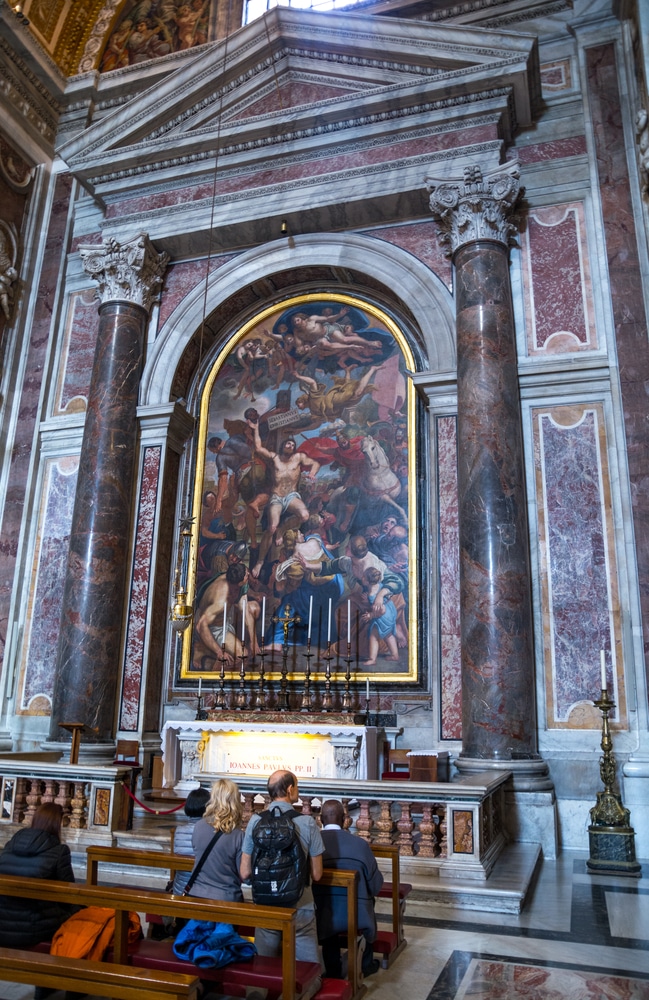 Source: S.Tatiana / Shutterstock
Source: S.Tatiana / ShutterstockThe Chapel of St Sebastian, which is the second on the right along the basilica’s north aisle, is the resting place of Pope John Paul II (1920-2005).
His remains were moved here, close to Michelangelo’s Pietà, in 2011, to better accommodate the crowds wishing to pay their respects to this extremely popular figure.
Generally conservative, John Paul II is remembered for, among other things, working to improve relations between the Catholic Church and the other world faiths.
He had the second-longest papacy in the modern era (1978 onward) and was one of the most travelled world leaders in history, visiting 129 different countries.
In keeping with his wishes, and those of his predecessor, Paul VI, the tomb is unadorned, with a simple altar bearing the inscription “BEATVS IOANNES PAVLVS PP. II”.
The ceiling has 17th-century Baroque frescoes by Pietro da Cortona, and above the altar is a mosaic by Pier Paolo Cristofari, depicting the martyrdom of St Sebastian.
24. Sant’Anna dei Palafrenieri
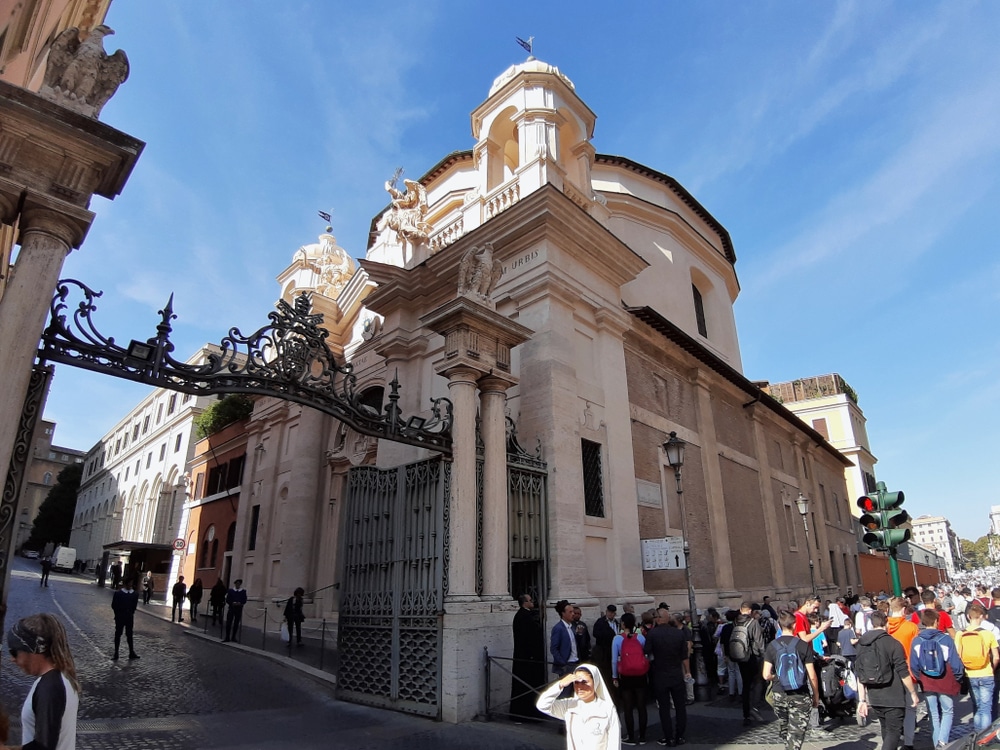 Source: Lucamato / Shutterstock
Source: Lucamato / ShutterstockVatican City’s parish church is right on the eastern gate, Porta Sant’Anna, and was begun in 1565.
This building, designed by the great Mannerist architect Giacomo Barozzi da Vignola, carries plenty of significance.
Vignola is famed for Rome’s Church of the Gesù, which introduced the Baroque into architecture for the first time, and became a template for Jesuit churches around the world.
Sant’Anna dei Palafrenieri meanwhile was one of the first churches in Rome to have an elliptical plan, which would later become a signature for Baroque church design.
Much of the interior decoration comes from the 18th century when the church was completed.
Head in to admire the dome, decorated with stucco work depicting the Dove of the Holy Spirit. The nave is walled by eight Corinthian columns, framing scenes from the Life of St Anne, painted by Austrian Baroque artist Ignazio Stern (1679-1748).
25. Porta Pertusa
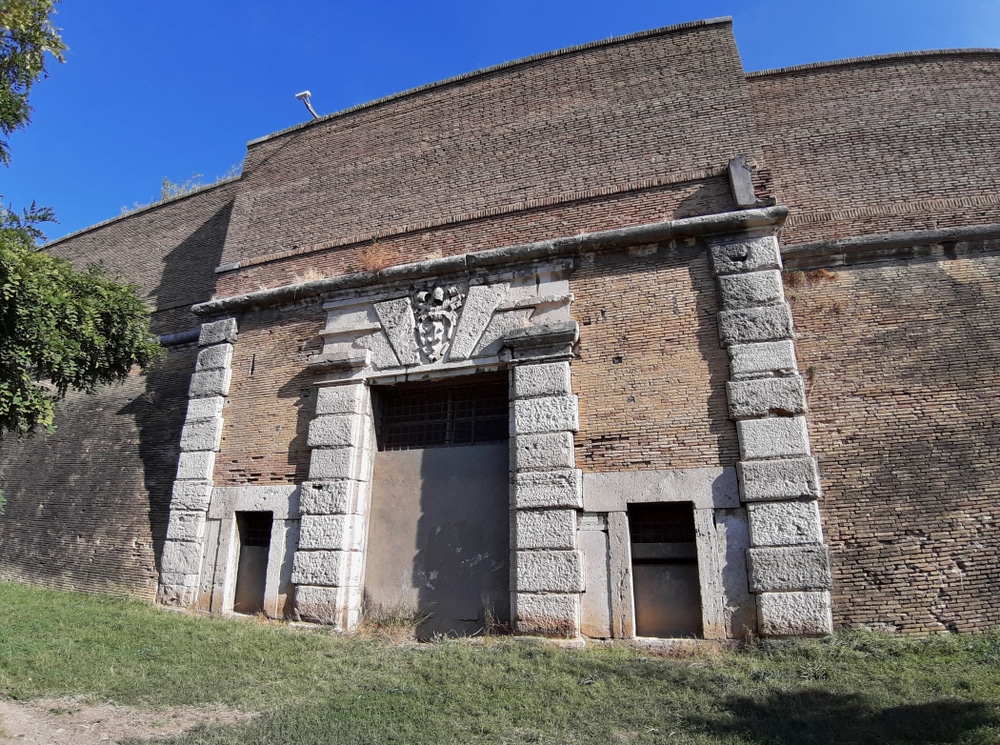 Source: Lucamato / Shutterstock
Source: Lucamato / ShutterstockIf you want to leave no stone unturned you could wander around the Vatican’s forbidding Leonine Wall to this historic, sealed-up gate on Viale Vaticano.
As with the Porta Cavalleggeri, which opens onto St Peter’s Square, this gate was most likely created in the 14th century by drilling into those 9th-century defences.
The return of the popes from Avignon, and the large retinue that came with them, meant that the Vatican’s three entrances were insufficient.
The current ashlar stonework crested by the Medici coat of arms and backed by the Tower of San Giovanni, dates to the time of Pope Pius VI in the 1560s.
Porta Pertusa has spent much of its history closed up, and has only been opened on certain occasions.
One of these was the arrival of Christina, Queen of Sweden in Rome in 1655, ruler of the Swedish Empire who abdicated and converted to Catholicism and is one of the few women buried in the Vatican grotto.